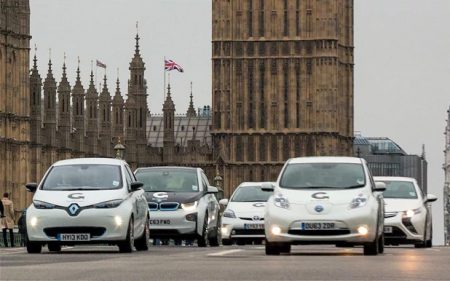To reduce carbon emissions, electric vehicles need to stay on the road as long as possible. That means developing a robust trade in secondhand cars.
ELECTRIC VEHICLES ARE getting more popular. Now they’re getting flashy too: new electric pickup trucks, new electric semis, new electric sports cars, a new electric G-Wagen.
But all that zippy sexiness only matters to a small slice of the US. Seventy percent of the vehicles sold in the country last year were used, according to data from Edmunds. So when Americans go electric, most will do it in a used vehicle.
There’s more than thrift involved. “If we’re serious about meeting climate change goals, we need to get rid of every internal combustion engine in the next 15 to 20 years,” says Ryan Sclar, who researches electric mobility at the World Resources Institute. “We’re not going to get there without utilizing the used market.” It’s critical, he says, that electric vehicles stay on the road as long as possible—no matter how many times the keys change hands.
Until now, though, there hasn’t been much of a market for used electric vehicles. For one, there haven’t been many used electric vehicles to buy. EVs didn’t reach even 1 percent of US vehicle sales until 2017. If you’re looking for an older EV, the pickings can be slim.
But there wasn’t much demand for used electrics, either. Most new EVs were leased, and when the leases expired, dealerships complained that they languished on the lot. The anxiety about range that afflicts new-car shoppers affects used shoppers too—but worse, as prospective buyers fret that the expensive batteries inside the vehicles might degrade all at once. The first generation of electric vehicles had a reputation for poor performance. That stuck around for a while.
“The notion was that someday this battery—this giant, expensive battery—is going to die for good, and that the owner is going to be on the hook for the replacement,” says Joe Wiesenfelder, executive editor at the online car marketplace Cars.com. “People were very afraid that a used car was much closer to the graveyard in ways internal combustion engine cars weren’t. But that was a false assumption on a lot of people’s parts.”
Now, more capable electric vehicles, with ranges exceeding 100 miles, are making their way to used car lots, like BMW i3s, Nissan Leafs, and Volkswagen E-Golfs from 2014 and later. As the market develops, some say it’s not too early to think about ways to support it.
The electric market may be like a flywheel: Get it spinning and you won’t have to worry about keeping it spinning. “Will a lot of the concerns and barriers to entry on electric vehicles erode in the next three to five years? Absolutely,” says Karl Brauer, an executive analyst at the vehicle research company iSeeCars.com. “It’s just kind of an inevitable trend.”
Ranges for new vehicles keep increasing, and batteries (which cost upwards of $5,000 to replace) have not degraded in the way some folks had feared. Some of the EV-curious also seem to be realizing that they don’t need an expensive car with a 300-mile range to get through their daily routines, especially if they have another car for longer trips.
Omar Islam got interested in electric vehicles because of Tesla, but he knew he couldn’t afford one. So he purchased a used 2013 Nissan Leaf two years ago. When the car was new—and cost $36,000—its range maxed out at 75 miles; by the time Islam bought it off Craigslist for $6,000, it got 69 to 71 miles per charge. That was more than enough for his daily driving around Marietta, Georgia, where he lives. He adored the car—until a collision took it out of service. “If I had the funds, I would buy that same car all over again,” he says.
Today, those like Islam interested in used EVs can generally find a good deal—in part, for the reason that makes some in the electric vehicle industry nervous. Thus far, electric vehicles have depreciated pretty quickly. (The exception is Tesla; its luxury cars tend to hold their value better.) If you don’t think you’ll be able to sell your car at a good price, you might not buy one to begin with. “The used car market is critical for the adoption of new cars,” says Gil Tal, who directs the Plug-in Hybrid & Electric Vehicle Research Center at UC Davis.
Tal has done research on buyers of used electrics in California, which suggests that they’re likelier to have lower incomes and rent their homes than the folks who are buying the cars new. Other research, led by University of Washington civil and environmental engineering professor Don MacKenzie, finds used EV buyers are likelier to be what they call “garage orphans”—people who park on the street or in a parking lot, making it harder to charge the car. That raises questions about the infrastructure needed to support them, such as public charging stations.
A federal program that for years handed out $7,500 in subsidies to battery electric buyers does not apply to used cars (it is now winding down), and many state subsidies only apply to new EVs. Now California, the nationwide leader in all things electric vehicle, has started to think about creative ways to help out the used car market, and potential used EV buyers. One two-year-old program offers grants and financing to low- and moderate-income drivers—for a family of four, those with annual incomes up to $105,000—to help them purchase or lease EVs, including used ones. Another, in the works but not yet funded, could finance battery or fuel cell replacements in cars that are past their prime.
Read more: Wired
It’s Time to Go Green!
If you would like to know more about Solar Panels and the PowerBanx range of home battery systems, and get a free instant quote, please complete our online form:


